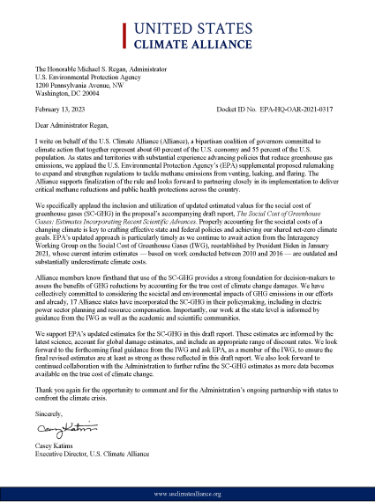Home / U.S. Climate Alliance Encourages EPA to Update Social Cost of Greenhouse Gases Estimates
- Letter
U.S. Climate Alliance Encourages EPA to Update Social Cost of Greenhouse Gases Estimates
February 13, 2023
Alliance members know firsthand that use of the social cost of greenhouse gases (SC-GHG) provides a strong foundation for decision-makers to assess the benefits of GHG reductions by accounting for the true cost of climate change damages. We have collectively committed to considering the societal and environmental impacts of GHG emissions in our efforts and already, 17 Alliance states have incorporated the SC-GHG in their policymaking, including in electric power sector planning and resource compensation. Importantly, our work at the state level is informed by guidance from the IWG as well as the academic and scientific communities.
We support EPA’s updated estimates for the SC-GHG in its draft report, The Social Cost of Greenhouse Gases: Estimates Incorporating Recent Scientific Advances. These estimates are informed by the latest science, account for global damage estimates, and include an appropriate range of discount rates.
About the Alliance
Launched in 2017 by the governors of Washington, New York, and California to help fill the void left by the U.S. federal government’s withdrawal from the Paris Agreement, the Alliance has grown to include 24 governors from across the U.S. representing approximately 60 percent of the U.S. economy and 55 percent of the U.S. population. Governors in the Alliance have pledged to collectively reduce net greenhouse gas emissions by at least 26-28 percent by 2025, 50-52 percent by 2030, and 61-66 percent by 2035, all below 2005 levels, and collectively achieve overall net-zero greenhouse gas emissions as soon as practicable, and no later than 2050.
The Alliance’s states and territories continue to advance innovative and impactful climate solutions to grow the economy, create jobs, and protect public health, and have a long record of action and results. In fact, the latest data shows that as of 2023, the Alliance has reduced its collective net greenhouse gas emissions by 24 percent below 2005 levels, while increasing collective GDP by 34 percent, and is on track to meet its near-term climate goal of reducing collective greenhouse gas emissions 26 percent below 2005 levels by 2025.
###
